“Enables delicious combinations of vintage colors and contemporary tones that invite creative exploration.” – “The tremolo pulses are wonderfully organic”- “The reverbs are similarly intoxicating” – Premier Guitar
“What’s best is that it all sounds great. The pedal is fun to play with almost anything plugged into it” – The Deli
“The Flint is unbelievably musical and infinitely usable” – Guitar Player


Sound Clips
Harmonic Tremolo and Reverb:
This example pairs the ’61 Harmonic Trem with the ’60s Reverb. The reverb is first in the chain, true to a vintage combo amp. The harmonic trem creates a nice fat sound for some up-tempo slide work, and the reverb adds some more depth at at a lower Mix setting.
Create some unique sounds by adjusting the speed knob in real time using an expression pedal. Using the ’61 Harmonic Tremolo and a mild ’70s Reverb, the speed knob is adjusted between 9:00 and 12:00.
Listen for the mild phaser effect that is a signature element of the ’61 Harmonic Tremolo. In this example the Tremolo is routed after the ’70s Reverb, which gives the reverb trails a choppy quality.
Using the ’70s Reverb, Decay is set to near maximum. The ’61 Harmonic Tremolo intensity starts off at zero, and at 0:47 is set to noon.
Check out the phasey nature of this slow ’61 Harmonic Tremolo. This clip features the ’70s Reverb.
Here we’re employing the ’80s Reverb with a very long and mellow Decay. The ’61 Harmonic Tremolo is engaged at 0:26, where it is routed before the reverb.
Tube Tremolo and Reverb:
The ’60s Reverb feeds into a ’63 Tube trem to produce a classic combo amp tone.
The ’63 Tube Tremolo with maximum Intensity and slow Speed creates a hypnotic, soothing pulse. The ’60s reverb is added first to fill the trem envelope further.
Here the Speed is increased and the Intensity decreased to accent some fast finger-picking. Again, a dose of ’60s Spring fattens up the signal feeding the ’63 Tube Tremolo.
The ’63 Tube Tremolo with moderate Intensity and quicker Speed creates the locomotion for this train of blues. The ’70s Reverb is used in front of the trem, filling out the signal and accentuating the trem envelope.
This clip features the ’70s Reverb with maximum decay running into the ’63 Tube Tremolo. Initially the Trem Intensity is set to zero, and then is gradually increased to maximum and then decreased back to zero Intensity, all while the reverb continues its decay.
Using a mild ’63 Tube Tremolo and ’80s Reverb with long decay times, you can generate some very serene and subtly moving pads.
Photocell Tremolo and Reverb:
The ’80s Reverb is set to high mix with a long decay, feeding into the ’65 Photo Trem to produce a turbulent wall of sound.
By following the ’65 Photo Trem with the ’70s Reverb, some mysterious and moody sounds are produced.
Granny liked a good melody. The ’65 Photo Tremolo feeds the ’70s Reverb to add a sultry quality to this melodic piece.
Using the ’65 Photo Tremolo and a very subtle ’70s Reverb, we adjust the Speed from 9:00, to 12:00, to 3:00, then to maximum, then to minimum.
’80s Reverb with ’65 Photo Tremolo used to create a warbling spacey pad. At about 0:31 the Intensity is brought down to minimum, and then back up at the end.
Tremolo only:
The ’61 Harmonic Tremolo adds a mellow vibe and chewy goodness to some simple chords.
The first part has a slow Speed with maximum Intensity, highlighting the depth and fullness that the tube tremolo produces. The second part brings the Intensity down and increases the speed just a bit to complement some soft arpreggiated chords.
The ’65 Photo Tremolo gets wound up to produce a frenetic, choppy trem with Intensity and Speed at maximum.
We start off with the ’65 Photo Tremolo, switch to ’63 Tube Tremolo at 0:09, and then to ’61 Harmonic Tremolo at 0:22.
Reverb only:
This clip highlights the dynamics of the spring tank with a surfy twang. With a high Mix, the Spring Reverb creates a classic splash when hit with a strong attack.
The ’70s Reverb is showcased, featuring a rich, dense, and natural sound.
The ’80s Reverb is featured, with it’s slowly building density, warmth, and overall ‘big’ sound.
The ’80s Reverb with maximum decay achieves a synth-like wash of sustain. The modulating delay lines inject just the right amount of movement, depth and warmth.
A Perfect Gentleman — From a Classic Era.
The magical combination of tremolo and reverb is the earliest example of a perfect guitar effects marriage. First pioneered within historic amplifiers of the 1960s, this harmonious coexistence has made it’s way onto countless records and performances—from early surf, swampy bayou blues, spaghetti westerns, film noir soundtracks, to modern day indie rock. There are certain things in life that just belong together—the blend of tremolo and reverb create the perfect pair.
Given this storied history, there was no doubt that we wanted to develop a studio-class effects pedal that delivers this classic combination. We carefully studied our favorite classic tremolo and reverb circuits, examined the sonic complexities, and faithfully accounted for every detail in our hand-crafted algorithms. Flint harnesses the complete power of a SHARC DSP to authentically exhibit these details.
Flint gives you the soothing, pulsating, and hypnotic effects that were pioneered in vintage amplifier tremolo circuits, along with three classic and completely unique reverb algorithms. You get the sonically complex ’61 Harmonic Tremolo, the swampy and sultry ’63 Power Tube Tremolo, and the sharp and balanced ’65 Photocell Tremolo. You also get the classic ’60s Spring Tank Reverb, the inventive ’70s Electronic Plate Reverb, and the nostalgic ’80s Hall Rack Reverb.
With eight parameters to tweak, you get extensive control over the tremolo and reverb characteristics. Go from splashy, pulsing twang, to throbbing, swampy blues, all the way to ambient, trembling, and serene reverberated pads. Couple that with true bypass, and a high quality analog front end and output section, and you have yourself the history of tremolo and reverb in a pedal-board friendly format.
Tremolo Types
Flint provides you with three distinct tremolo types. Read our Tremolo white paper and learn how we studied and captured these sonic details.
- ’61 Harmonic
- ’63 Power Tube
- ’65 Photocell
| The ’61 Harmonic Tremolo is somewhat rare due to its very short period of availability in tube amplifiers in the early 1960s. It gets its signature sound through a dual-band filtering effect that alternately emphasizes low and high frequencies. The end-result is a soothing pulse that has shades of a mild phaser effect combined with tremolo due to the nature of the frequency bands that are alternated. |
| The ’63 Power Tube Tremolo utilized the LFO signal to directly influence the power tube bias of the amplifier’s push-pull output stage. The power tubes are biased into lower and higher idle currents, creating the fluctuating gain that produces the tremolo effect. The effects of crossover distortion at low tremolo volumes, increased power tube harmonic distortion at maximum tremolo volumes, as well as the influence of power-supply sag, all add up to the boggy and dirty nature of this tremolo circuit. |
| The ’65 Photocell Tremolo is a faithful recreation of the classic photo-trem circuits found in mid-1960s American amplifiers. Those classic circuits used a light-dependent resistor to attenuate the input signal, coupled with a miniature neon bulb that is connected to the LFO. As the LFO oscillates, the bulb gets brighter and dimmer which in turn varies the resistance of the LDR. The varying resistance works with other circuit impedances to change the signal level, which produces a characteristically ‘hard’ sounding tremolo that moves between two levels, reminiscent of a square wave. |
Reverb Types
Flint gives you three unique reverb types. Read the Flint reverb summary for in-depth details on these reverbs.
| The ’60s Spring Tank Reverb is our faithful recreation of the full-size two-spring tank that was commonly used in vintage amps. The two-spring tank uses spring segments of differing delay times, which adds to the complexity of the reverberated sound. Contributing greatly to the sound are the input and output tube circuits which convert the electrical guitar signal into a mechanical signal and then back to an electrical signal. |
| The ’70s Electronic Plate Reverb pays homage to one of the earliest digital reverbs ever created. The astounding hardware-based algorithm used multiple delay-lines configured in parallel, with each delay featuring multiple output taps and filtered feedback paths. The result is a rich, smooth reverb with a very quick build-up in density due to the summation of the many parallel output taps. |
| The ’80s Hall Rack Reverb is our rendition of the now nostalgic digital microprocessor rack reverbs from the late ’80s. The limited processing power of the day led to the implementation of efficient regenerative series loops of all-pass filters, delays, and low-pass filters. Modulating delay lines were used to increase the reverb density and add warmth. This reverb provides the signature sound of distinctive early reflections followed by the slowly-building density of the late reverberation. |
More Features
- Expression Pedal Input
- Individual Bypass
- TRS Stereo
| This multi-function input can be configured for use with anexpression pedal, external tap tempo footswitch, or Favorite switch. Set up for an expression pedal and you get assignable expression control over any front-panel knob parameter. Set up for an optional external tap switch and remotely tap in your tremolo speed. Set up for our optional Favorite switch and save a favorite preset. |
| Separate bypass footswitches allow you to bypass the tremolo and reverb individually. |
| We know that there are some out there that like to run stereo rigs. This is why we’ve added the option of running your Flint in stereo. Flip a jumper inside your pedal, use a TRS splitter cable, and now you’ve got yourself a stereo pedal. |
Features and Specs
- Sound Design
- Ins, Outs, Switches
- Audio Quality
- More
- Three hand crafted tremolo algorithms faithfully deliver classic tremolo experiences:
’61 Harmonic Tremolo, ’63 Power Tube Tremolo, ’65 Photocell Tremolo - Three distinct reverb algorithms:
’60s Spring Tank Reverb, ’70s Electronic Reverb, ’80s Hall Rack Reverb - Two tremolo adjustment and tone shaping knobs: Intensity, Speed
- Three reverb adjustment and tone shaping knobs: Decay, Color, Mix
- Four “hidden” knobs for extensive tone tweaking:
Tremolo Boost/Cut, Reverb Boost/Cut, Effect Order, Tap Subdivision
- High impedance mono input (internal jumper enables selectable TRS stereo input)
- Stereo output
- Tremolo Bypass and Reverb Bypass footswitches
- Expression pedal input allows the connection of either an expression pedal (for selectable control over any knob parameter), external tap pedal (for remote tap tremolo), or Favorite switch (to save a Favorite preset)
- Super low noise, high performance 24-bit 96kHz A/D and D/A converters
- 115db typical signal to noise
- +8dBu maximum input level easily handles instrument and line signals
- 20Hz to 20kHz frequency response
- Premium analog front end and output section
- Analog dry path (when Reverb only is engaged)
- Super high performance DSP in a compact form factor
- 32-bit floating point processing
- True Bypass (electromechanical relay switching)
- Selectable “trails” mode with high quality Analog Buffered Bypass
- Adjustable +/- 3dB boost or cut when effect is engaged
- Powered with a standard 9V center negative DC supply, 250mA minimum
- Strong and lightweight black anodized aluminum chassis
- Crafted with love in the USA

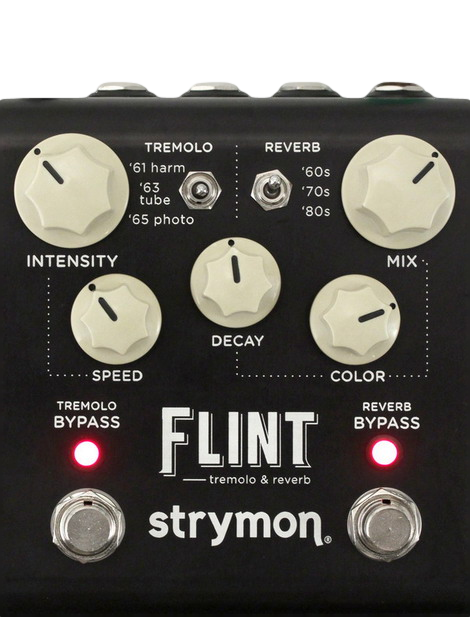
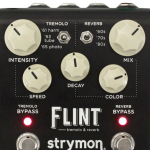
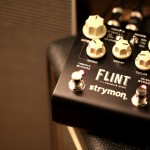
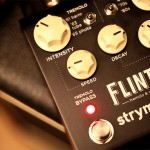
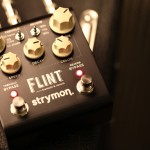
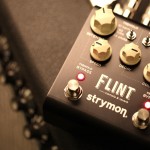

Be the first to review “STRYMON FLINT”
Devi essere connesso per inviare un commento.